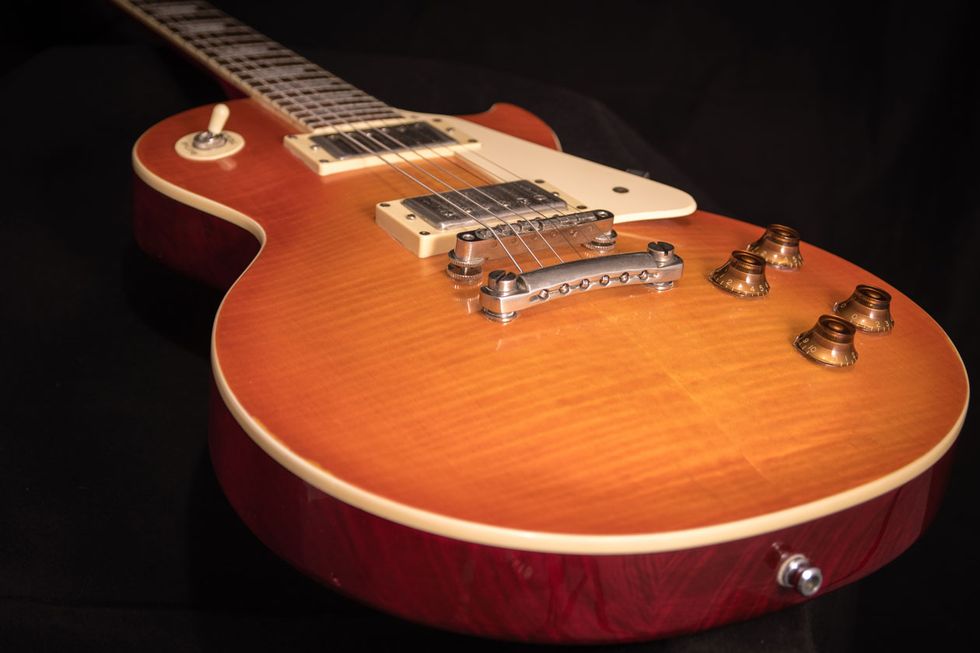Guitarists often grow tired of the overly familiar sound associated with the minor pentatonic scale, which has become the go-to device for blues and rock improvisation. As we progress on the instrument and explore classic rock and blues licks, we often discover that many stock phrases contain a blend of major and minor pentatonic tones.
A pentatonic scale can contain any five notes, so let’s introduce a new scale that uses the four notes of a dominant 7 chord, plus a 4. We’ll call it the Mixo-pentatonic scale, but feel free to give it your own name. If we were soloing over an E7 chord (E–G#–B–D), our Mixo-pentatonic scale would be E–G#–A–B–D (1–3–4–5–b7).
You can think of this scale as a pentatonic version of the Mixolydian mode, which has a formula of 1–2–3–4–5–6–b7. In this instance, it would be derived from E Mixolydian (E–F#–G#–A–B–C#–D).
By skipping the 2, the sound is less like a traditional major scale or corresponding mode, and the half-step between the 3 and 4 suggests an Eastern quality, something you might hear in the playing of George Harrison or John McLaughlin.
Ex. 1 shows a one-octave pattern for the E Mixo-pentatonic scale followed by an open-position E7 chord. With alternate picking, play through the scale while listening to the sound of the dominant 7 chord. Then try improvising with the scale in this position—you may even stumble onto a Led Zeppelin riff!
Click here for Ex. 1
Ex. 2 contains two single-octave patterns for the E Mixo-pentatonic scale; each pattern is followed by an E7 chord in its respective position. Again, play the scale using alternate pick strokes and remember: It’s always worthwhile to connect a scale with its corresponding chord shape. This will help you identify chord tones when soloing, an approach that creates melodic lead lines.
Click here for Ex. 2
Ex. 3 demonstrates a lick played out of the E Mixo-pentatonic scale, performed at two tempos. The lick begins on the root note and contains a descending pattern before ending on the b7. Practice it slowly and gradually raise the tempo. In measure three, notice how pull-offs give the lick a smooth rolling feel on its descent. At faster tempos, the lick is reminiscent of something Eric Johnson might play.
Click here for Ex. 3
Let’s move to a new key for Ex. 4, which shows a two-octave A7 arpeggio (A–C#–E–G) played as eighth-notes, followed by a two-octave pattern of the A Mixo-pentatonic scale (A–C#–D–E–G). Notice that the scale contains the same notes as the arpeggio, but with the additional 4. It’s important to connect the scale to the arpeggio and be able to improvise with it in different keys.
Click here for Ex. 4
Next up is Ex. 5, which demonstrates a lick that stays with the A Mixo-pentatonic scale. We begin in measure one with a slide from the 3 to the 4 against the A7 chord. The intervallic theme is then repeated with a half-step bend and release, once more from the 3 to the 4. In measure two, we repeat the bend once again and release twice more before resolving back to the root and b7 of the chord. The fast half-step bends featured in this lick have a Jeff Beck-inspired quality.
Click here for Ex. 5
Ex. 6 is a melodic lick also played against an A7, but this time we use string skipping to bring out the intervals of the Mixo-pentatonic scale. The fast 16th-note run just might amaze your friends! Notice how the hammer-ons and pull-offs in measure four give the scale run a legato feel.
Click here for Ex. 6
As demonstrated in Ex. 7, incorporating this scale into blues improvisation is a nice way to suggest a mood shift away from traditional blues clichés. We begin in measure one with a melodic phrase over the E7 chord and then return to it in measure three. By using such devices as a swing feel, bends, and hammer-ons/pull-offs, we give the phrase more personality and avoid sounding as though we’re simply running up or down a scale.
Click here for Ex. 7
We continue with E7 blues in Ex. 8. By using the E minor pentatonic scale (E–G–A–B–D) for the opening IV chord (A7), we get a nice selection of chord tones/extensions at our fingertips (5–b7–R–9–4). This also brings the more familiar blues-rock tonality to the music, which in turn is a nice contrast to the more melodic-sounding Mixo-pentatonic we previously used on the I chord (E7) and return to in measures three and four.
Click here for Ex. 8
Ex. 9 combines the previous two examples so we can hear them in the context of the first eight measures of a standard 12-bar blues progression. Listen for the contrast between the Mixo-pentatonic and the minor pentatonic scales.



















